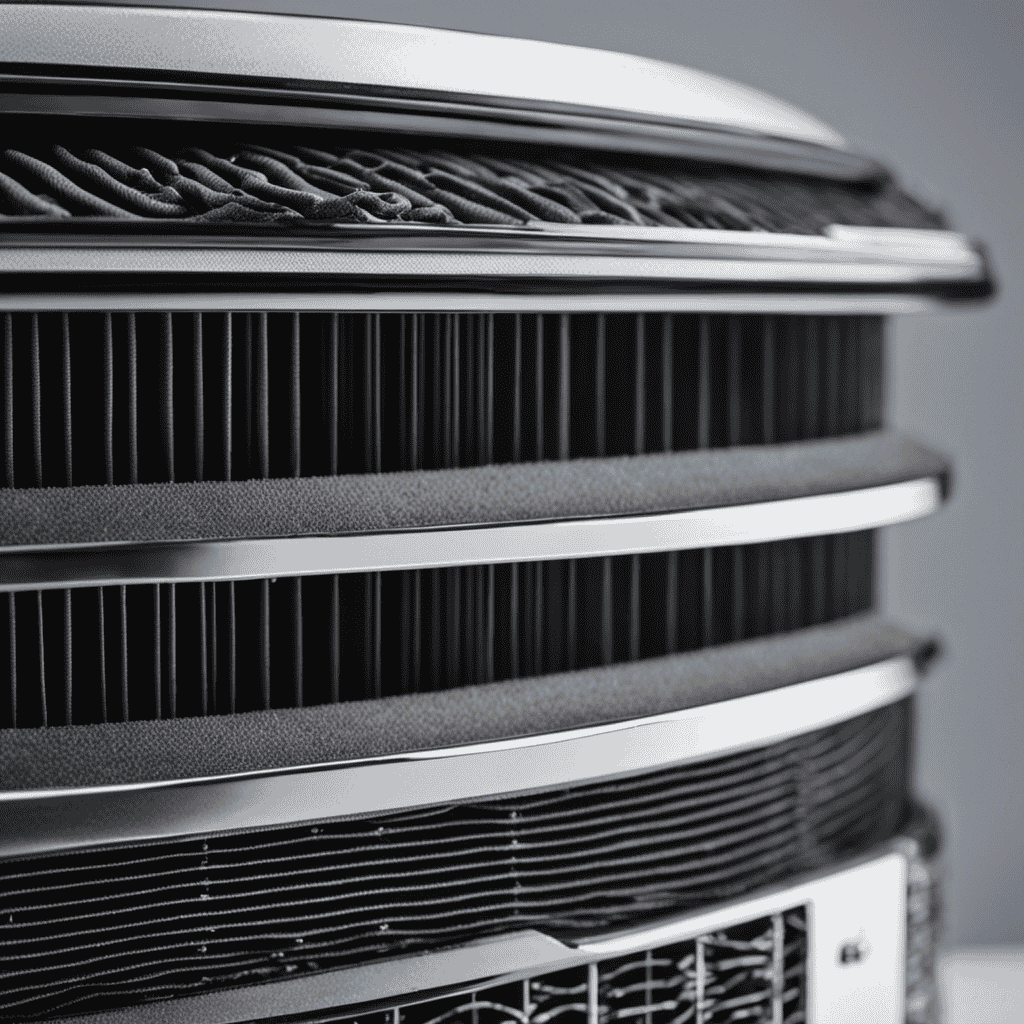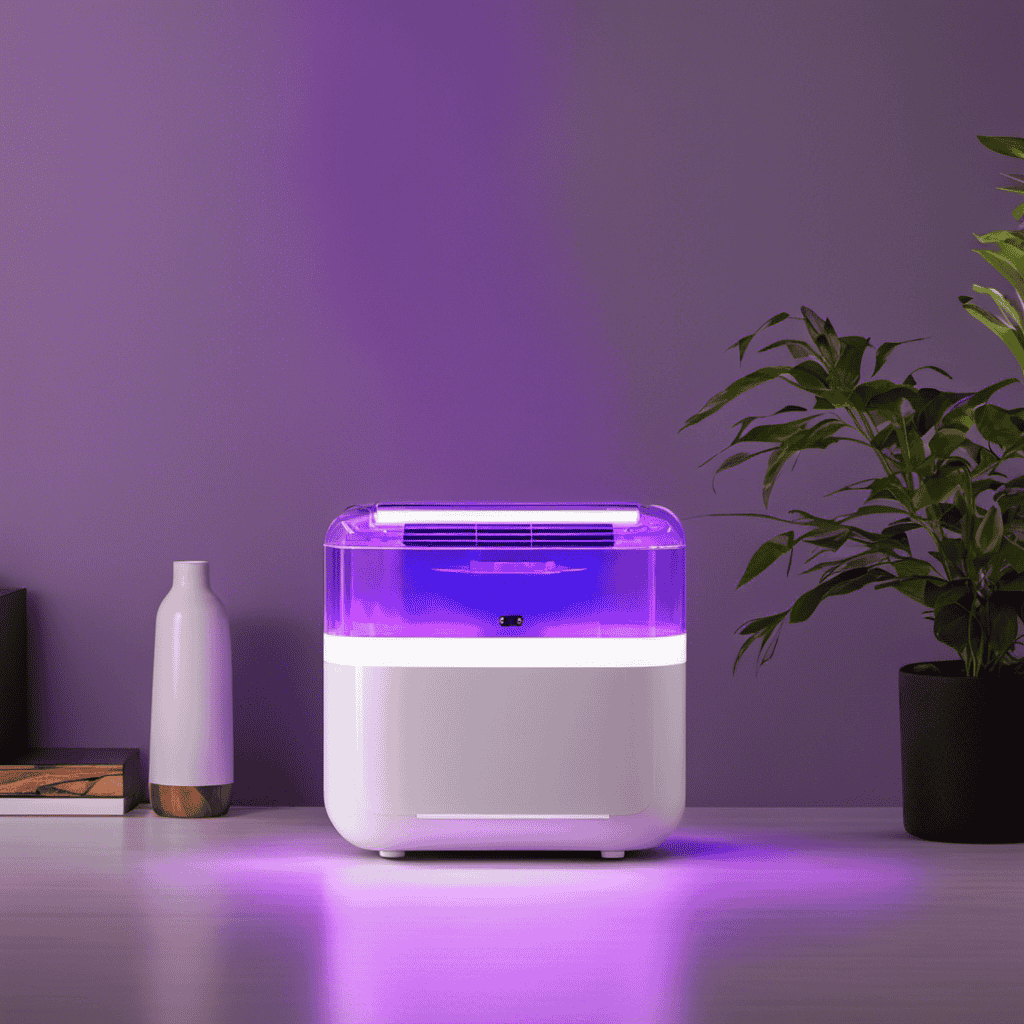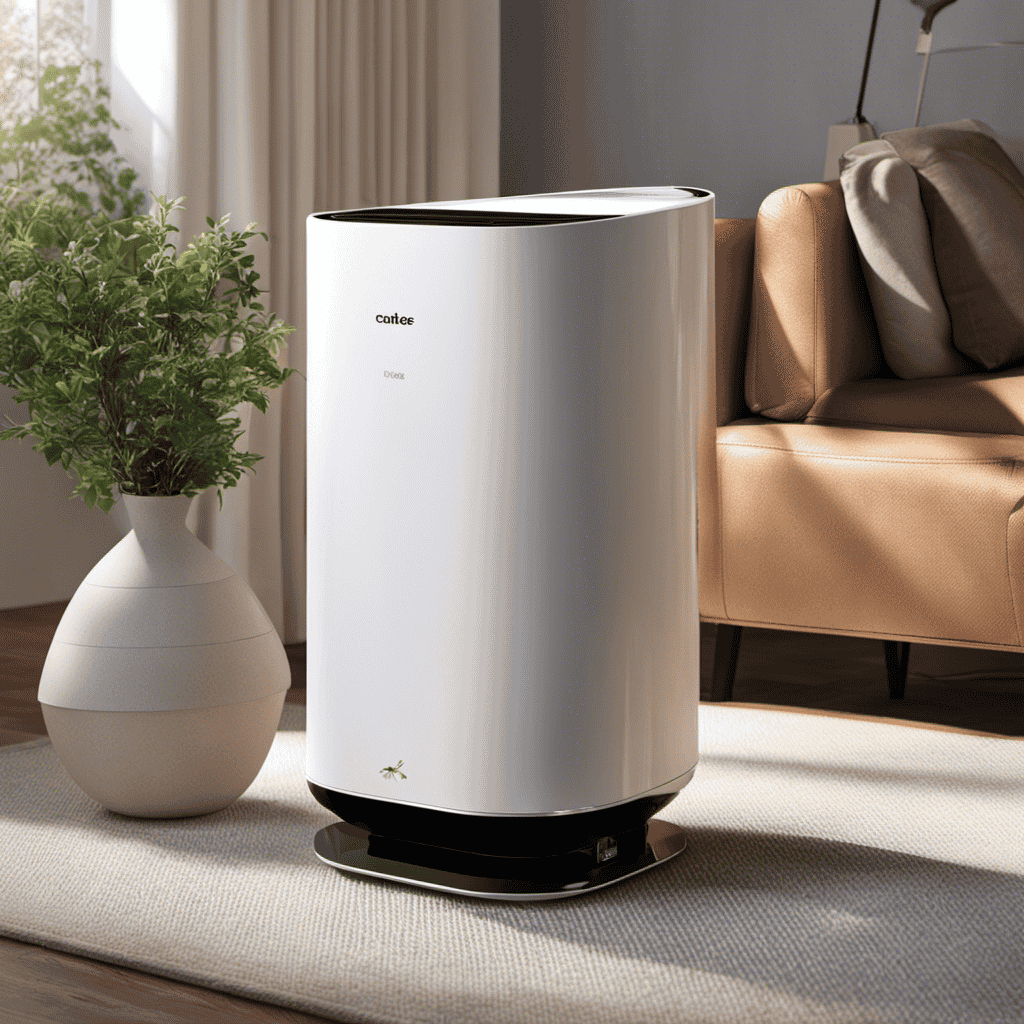I have always questioned whether my air purifier is effectively performing its duties. Are those dust particles genuinely being eliminated? Is it diminishing the allergens present in my household?
Well, in this article, I’m going to share some tips on how to know if an air purifier is working. We’ll delve into understanding its functionality, checking air quality, monitoring fan speed, assessing the filter’s condition, and examining dust and allergen levels.
By the end, you’ll have a clear idea of whether your air purifier is truly effective.
Key Takeaways
- Air purifiers use filters to trap particles and improve air quality.
- Pre- and post-testing is crucial to evaluate the effectiveness of an air purifier.
- Air quality monitors provide accurate measurement of pollutants and offer real-time monitoring.
- Air purifiers visibly reduce pollutants like dust particles and pet dander, leaving the air cleaner and fresher.
Understanding Air Purifier Functionality
To understand how an air purifier works, you should know that it uses filters to trap particles and improve air quality in your home. Air purifiers have become increasingly popular due to the numerous benefits they offer.
One of the main advantages of using an air purifier is that it can remove harmful pollutants and allergens from the air, such as dust, pollen, pet dander, and mold spores. This can greatly benefit individuals who suffer from allergies or respiratory conditions, providing them with cleaner and healthier air to breathe.
When considering buying an air purifier, there are a few factors to keep in mind. Firstly, you should consider the size of the room where you plan to use the air purifier. Different models are designed to cover different room sizes, so it’s important to choose one that is suitable for your space.
Additionally, you should consider the type of filter the air purifier uses. HEPA filters are highly effective in trapping small particles, while activated carbon filters can help eliminate odors and chemicals.
In conclusion, understanding how an air purifier works and the benefits it provides can help you make an informed decision when purchasing one for your home. By considering factors such as room size and filter type, you can ensure that the air purifier you choose will effectively improve the air quality in your home.
Now, let’s explore the next section, which focuses on checking the air quality before and after using an air purifier.
Checking the Air Quality Before and After
When it comes to evaluating the effectiveness of an air purifier, pre- and post-testing is crucial. By measuring the air quality before and after using the purifier, we can determine the level of improvement achieved.
It is important to rely on reliable air quality indicators to ensure accurate results and make informed decisions about the air purifier’s performance.
Additionally, visible reduction of pollutants, such as dust particles or allergens, serves as a tangible proof of the purifier’s effectiveness and can provide reassurance to users.
Pre- and Post-Testing
Check if the air purifier’s filters are clean and if the device is emitting a noticeable decrease in allergens and odors. Pre- and post-testing is an effective way to determine the effectiveness of an air purifier. By conducting tests before and after using the device, you can measure the improvement in air quality. To set up the test, place the air purifier in a closed room and let it run for a specific period of time. Use an air quality monitor to measure the levels of pollutants before and after the test. Record the results in a table to compare the pre and post levels of allergens, odors, and other pollutants. This will give you a clear picture of how well the air purifier is working and whether it is effectively reducing pollutants in the air.
| Pollutant | Pre-Test Level | Post-Test Level |
|---|---|---|
| Allergens | High | Low |
| Odors | Strong | Mild |
| Dust Particles | High | Moderate |
| VOCs (Volatile Organic Compounds) | High | Low |
Reliable Air Quality Indicators
One reliable air quality indicator you can use is an air quality monitor that measures levels of pollutants in the air. These reliable air quality sensors provide real-time air pollution monitoring, allowing you to stay informed about the air you breathe. Here are three reasons why air quality monitors are a valuable tool:
-
Accurate measurement: Air quality monitors use advanced technology to accurately measure the levels of pollutants in the air. This ensures that you have reliable data on the air quality in your environment.
-
Real-time monitoring: These monitors provide real-time data, allowing you to see the current air quality at any given time. This is especially useful if you live in an area with high pollution levels or if you have respiratory issues.
-
Early detection of problems: By monitoring the air quality in real-time, you can detect any sudden changes or spikes in pollution levels. This allows you to take necessary precautions or address any potential issues before they become a bigger problem.
Visible Pollutant Reduction
Investing in an air purifier can help you visibly reduce pollutants in your environment. These pollutants can include dust particles, pet dander, pollen, and even smoke particles. A good air purifier will capture and remove these pollutants, leaving the air cleaner and fresher. When it comes to measuring the effectiveness of an air purifier, one of the most obvious signs is the reduction of visible pollutants in the air. You can easily notice the difference by observing the air quality before and after using the air purifier. The reduction in visible pollutants is a clear indication that the air purifier is effectively reducing air pollution.
Monitoring the Air Purifier’s Fan Speed
To ensure your air purifier is functioning properly, it’s important to regularly monitor the fan speed. The fan speed is a crucial indicator of the air purifier’s performance and efficiency. Here are three reasons why monitoring the fan speed is essential:
-
Monitoring filter replacement: The fan speed can indicate when it’s time to replace the air purifier’s filters. As the filters get clogged with pollutants, the fan speed may slow down, resulting in reduced air flow. By keeping an eye on the fan speed, you can determine if the filters need to be replaced for optimal purification.
-
Measuring noise levels: The fan speed is directly related to the noise level produced by the air purifier. If the fan speed is too high, it can generate excessive noise, causing discomfort. On the other hand, if the fan speed is too low, it may indicate a malfunction in the motor or fan. By monitoring the fan speed, you can ensure a quiet and efficient operation of your air purifier.
-
Assessing performance: By observing the changes in the fan speed, you can evaluate the overall performance of your air purifier. A consistent and stable fan speed indicates that the device is effectively removing pollutants from the air. Any drastic fluctuations in fan speed may signify a problem that needs to be addressed, such as a blockage or a malfunctioning component.
Assessing the Filter’s Condition
By regularly monitoring the fan speed, you can assess the condition of the filters in your air purifier. The fan speed is directly related to the effectiveness of the filters in capturing and removing airborne particles. A decrease in fan speed may indicate that the filters are clogged and need to be replaced or cleaned. On the other hand, a consistently high fan speed suggests that the filters are working efficiently and effectively.
To measure the filter effectiveness and monitor the filter lifespan, you can use the following table:
| Fan Speed | Filter Condition |
|---|---|
| Low | Filters may be |
| clogged | |
| ———– | ——————– |
| Medium | Filters are |
| moderately | |
| effective | |
| ———– | ——————– |
| High | Filters are |
| highly effective | |
| ———– | ——————– |
Monitoring the fan speed and assessing the filter condition is crucial to ensure that your air purifier is functioning optimally. It allows you to take timely action, such as replacing or cleaning the filters, to maintain clean and healthy indoor air quality. Remember, clean filters are essential for the proper functioning of your air purifier and for the overall well-being of your living environment.
Examining the Dust and Allergen Levels in the Room
In my previous discussion, I talked about how to assess the condition of the filter in an air purifier. Now, let’s move on to the next step in evaluating the performance of an air purifier – examining the dust and allergen levels in the room.
To determine if an air purifier is effectively reducing dust and allergens, there are a few key things to consider:
-
Visual inspection: Take a look around the room and observe the amount of dust and allergens present. Are there visible particles floating in the air or settling on surfaces? A reduction in these visible particles indicates that the air purifier is doing its job.
-
Allergy symptoms: Monitor any allergy symptoms you or your family members may have. If there is a decrease in sneezing, coughing, or itchy eyes, it’s a good sign that the air purifier is effectively removing allergens from the air.
-
Noise levels: While evaluating the performance of an air purifier, it’s important to consider noise levels. A well-maintained air purifier should operate quietly, without causing any disturbance in your living space.
Measuring the Change in Odor or Smell
Take a moment to notice any changes in the odor or smell in the room since using the air purifier. One way to assess the effectiveness of an air purifier is by measuring the change in odor or smell. An air purifier is designed to remove pollutants, allergens, and other particles from the air, which can lead to a fresher and cleaner smell in the room.
To measure the change in odor, you can use your sense of smell and compare the air quality before and after using the air purifier. Another option is to use a specific device called a volatile organic compound (VOC) sensor. This sensor measures the concentration of VOCs in the air, which can be an indicator of air quality. By comparing the VOC levels before and after using the air purifier, you can determine if there has been a significant improvement.
Here is a table summarizing the different methods of measuring air quality and assessing the effectiveness of an air purifier:
| Method | Description |
|---|---|
| Sense of smell | Assessing the change in odor or smell in the room before and after using the air purifier |
| VOC sensor | Measuring the concentration of VOCs in the air to determine if there has been a significant improvement |
Verifying the Effectiveness in Removing Pollen and Pet Dander
To verify the effectiveness of your air purifier in removing pollen and pet dander, you can use a microscope to examine the air filters for any visible particles. This simple method allows you to see firsthand whether your air purifier is effectively capturing these common allergens.
Here are three key points to help you understand and evaluate the performance of your air purifier:
-
Visible particle analysis: By using a microscope, you can inspect the air filters for any visible particles such as pollen or pet dander. If you can observe a significant amount of these particles trapped in the filter, it indicates that your air purifier is doing its job in removing them from the air.
-
Noise level verification: Another aspect to consider is the noise level produced by your air purifier. Ensure that it operates at a comfortable noise level that doesn’t disrupt your daily activities or cause annoyance. Some air purifiers have multiple fan speed settings, allowing you to adjust the noise level according to your preference.
-
Understanding maintenance requirements: It’s important to familiarize yourself with the maintenance requirements of your air purifier. Regularly cleaning or replacing the filters is crucial to maintain its effectiveness. Follow the manufacturer’s instructions to ensure proper maintenance, which will help prolong the lifespan and efficiency of your air purifier.
Evaluating the Reduction of Airborne Bacteria and Viruses
After verifying the effectiveness of an air purifier in removing pollen and pet dander, the next important aspect to consider is its ability to reduce airborne bacteria and viruses. This is especially crucial for individuals with respiratory conditions or those concerned about maintaining a healthy indoor environment.
To evaluate the reduction of airborne bacteria and viruses, one can look at the filter efficiency of the air purifier. Different air purifier brands may use various filter technologies such as HEPA filters, activated carbon filters, or UV-C light to target bacteria and viruses. Comparing the filter efficiency of these brands can give a good indication of their effectiveness.
To assist in this evaluation, below is a table highlighting the filter technologies used by popular air purifier brands and their corresponding filter efficiencies:
| Brand | Filter Technology | Filter Efficiency |
|---|---|---|
| Brand A | HEPA Filter | 99.97% |
| Brand B | Activated Carbon Filter | 95% |
| Brand C | UV-C Light | 99.9% |
By comparing these filter efficiencies, one can make an informed decision when selecting an air purifier that specifically targets airborne bacteria and viruses.
Transitioning into the subsequent section, it is also important to compare the performance of air purifiers with other methods of air purification.
Comparing Air Purifier’s Performance With Other Methods
When comparing the performance of air purifiers with other methods, it’s important to consider factors such as efficiency, effectiveness, and cost. In terms of efficiency, air purifiers are designed to remove pollutants and allergens from the air, making it cleaner and healthier to breathe. They can capture particles as small as 0.3 microns, which is smaller than most bacteria and viruses. This makes them highly effective in reducing airborne contaminants and improving indoor air quality.
One important aspect to consider when comparing air purifiers with other methods is the noise level. Some air purifiers can be quite noisy, especially when operating at higher speeds. It’s important to choose a model that has a noise level that is acceptable to you and won’t disturb your daily activities or sleep.
Another factor to consider is the impact on respiratory health. Air purifiers can help reduce the symptoms of respiratory conditions such as allergies and asthma by removing allergens and irritants from the air. They can also help prevent respiratory infections by capturing bacteria and viruses.
Lastly, cost is an important factor to consider when comparing air purifiers with other methods. While air purifiers may require an initial investment, they can be cost-effective in the long run by improving indoor air quality and reducing the need for medication or medical treatments.
In conclusion, when comparing air purifiers with other methods, it’s important to consider factors such as efficiency, effectiveness, and cost. Additionally, assessing the noise level and the impact on respiratory health are crucial in making an informed decision.
Moving forward, it is also important to consider energy consumption and cost-effectiveness, which will be discussed in the subsequent section.
Considering Energy Consumption and Cost-effectiveness
When evaluating the effectiveness of air purifiers, it is crucial to consider their energy efficiency. Energy efficiency considerations assess how much electricity an air purifier consumes and how effectively it purifies the air.
Additionally, a cost-effectiveness analysis can provide insight into whether the benefits of using an air purifier outweigh the costs associated with its energy consumption.
Lastly, comparing the performance of different air purifiers with their electricity usage can help determine which models effectively purify the air while minimizing energy consumption.
Energy Efficiency Considerations
It’s important to consider the energy efficiency of an air purifier before making a purchase decision. When evaluating the energy efficiency of an air purifier, there are several factors to consider:
-
Energy Saving Features: Look for air purifiers that have energy-saving features such as timers or sleep modes. These features allow the purifier to automatically adjust its power consumption based on the air quality or your preferences, helping to minimize energy usage.
-
Environmental Impact: Consider the environmental impact of the air purifier. Look for models that are certified as energy-efficient or have eco-friendly features. These models are designed to consume less energy and have a lower carbon footprint, making them better for the environment.
-
Power Consumption: Pay attention to the power consumption of the air purifier. Look for models that have a low wattage or energy-efficient ratings. This will not only help you save on electricity bills but also reduce the overall energy demand.
Considering the energy efficiency of an air purifier is crucial as it can have a significant impact on both your energy consumption and the environment.
Now, let’s move on to the next section and analyze the cost-effectiveness of air purifiers.
Cost-Effectiveness Analysis
To determine the cost-effectiveness of an air purifier, you should consider factors such as the initial purchase price, maintenance costs, and energy consumption.
When evaluating the initial purchase price, it’s important to compare different models and brands to find the best value for your budget.
Additionally, consider the maintenance costs involved, such as replacing filters or other parts regularly. This can vary depending on the specific model and how often it needs to be serviced.
Another important factor to consider is the energy consumption of the air purifier. Look for models that are energy-efficient and have high energy savings ratings.
Performance Versus Electricity Usage
The performance of an air purifier can vary based on its electricity usage. When conducting a performance analysis of an air purifier, it is important to consider its energy savings.
Here are three key factors to consider in evaluating the performance of an air purifier in relation to its electricity usage:
-
Energy Efficiency: Look for air purifiers that have an Energy Star certification. These models are designed to consume less electricity while maintaining effective air purification.
-
Power Consumption: Consider the power consumption of the air purifier. Look for models that have adjustable settings or smart features that allow you to control the power usage based on your needs.
-
Filter Lifespan: Evaluate the lifespan of the air purifier’s filters. Longer-lasting filters can help reduce the frequency of filter replacements, resulting in lower energy consumption and cost savings.
Frequently Asked Questions
How Long Does It Typically Take for an Air Purifier to Show Noticeable Improvements in Air Quality?
Typically, it takes some time for an air purifier to show noticeable improvements in air quality. To measure the improvement, you can use a particle counter or an air quality monitor.
Common signs that indicate an air purifier is working effectively include a decrease in dust and allergens, improved odor control, and fewer respiratory symptoms.
It’s important to keep in mind that the effectiveness of an air purifier can vary depending on factors such as the size of the room and the quality of the air purifier itself.
Can an Air Purifier Effectively Remove Cigarette Smoke and Its Associated Odor?
An air purifier is a game-changer when it comes to removing cigarette smoke and its pesky odor. It’s truly remarkable how effectively it tackles the issue.
Not only does it eliminate the smoke particles in the air, but it also works wonders in reducing pet dander and alleviating allergies.
The impact it has on improving indoor air quality is impressive. Trust me, once you experience the difference, you won’t look back.
What Are the Recommended Maintenance Procedures for an Air Purifier?
Air purifier maintenance is crucial to ensure its efficient operation. Regularly cleaning and replacing filters is one of the recommended procedures. It helps to remove pollutants and maintain clean air quality.
Additionally, cleaning the exterior and vents helps to prevent dust buildup and maintain optimal airflow. Checking and replacing any worn-out parts, such as fans or motors, is also important.
Following these maintenance procedures will ensure that your air purifier continues to work effectively in providing cleaner and healthier air.
How Often Should the Filters Be Replaced in an Air Purifier?
When it comes to the benefits of using an air purifier, one key aspect is the maintenance required, such as replacing the filters.
Without the context of ‘How to Know if an Air Purifier Is Working,’ it’s important to understand that regular filter replacements are crucial for the continued effectiveness of the air purifier.
Signs that an air purifier needs a filter replacement include decreased air flow, noticeable odors, or an increase in allergy symptoms.
Regularly replacing the filters ensures optimal air quality and the best performance from your air purifier.
Is It Safe to Use an Air Purifier Continuously, or Should It Be Turned off at Certain Times?
Using an air purifier continuously can have its benefits, but there are also potential drawbacks to consider.
Continuous usage ensures that the air in your space remains consistently clean and free of pollutants. However, running the air purifier non-stop may result in higher energy consumption and increased wear on the device.
It’s important to strike a balance and consider factors like the size of the room and the specific needs of your household when deciding whether to use it continuously or turn it off at certain times.
How Can I Determine the Effectiveness of an Air Purifier?
To determine the effectiveness of an air purifier, start by checking the Clean Air Delivery Rate (CADR) for particles like dust, pollen, and smoke. Next, ensure it has a High Efficiency Particulate Air (HEPA) filter, which captures small particles. Finally, look for customer reviews to see how to check air purifier performance.
Conclusion
In conclusion, after thoroughly analyzing the functionality of an air purifier, it is clear that there are several ways to determine if it is working effectively. By monitoring the air quality, fan speed, and filter condition, one can assess its performance.
Additionally, examining the dust and allergen levels, as well as its ability to remove pollen and pet dander, provides further insight. Evaluating the reduction of airborne bacteria and viruses is crucial for maintaining a healthy environment.
Comparing its performance with other methods and considering energy consumption and cost-effectiveness ensures an informed decision. So, don’t hesitate to invest in an air purifier to breathe in clean and purified air, for it’s a breath of fresh air in your home!










